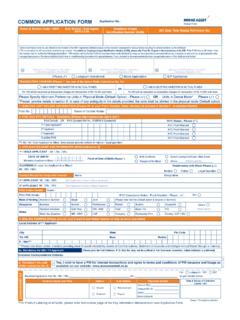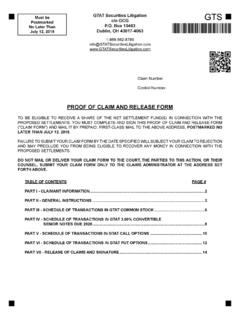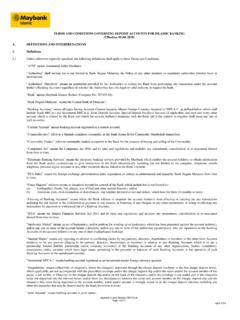Transcription of SUPREME COURT OF THE UNITED STATES - Tax Trials
1 1 ( slip Opinion) OCTOBER TERM, 2013 Syllabus NOTE: Where it is feasible, a syllabus (headnote) will be released, as isbeing done in connection with this case, at the time the opinion is syllabus constitutes no part of the opinion of the COURT but has beenprepared by the Reporter of Decisions for the convenience of the reader. See UNITED STATES v. Detroit Timber & Lumber Co., 200 U. S. 321, 337. SUPREME COURT OF THE UNITED STATES Syllabus UNITED STATES v. WOODS CERTIORARI TO THE UNITED STATES COURT OF APPEALS FOR THE FIFTH CIRCUIT No. 12 562. Argued October 9, 2013 Decided December 3, 2013 Respondent Gary Woods and his employer, Billy Joe McCombs, partici-pated in an offsetting-option tax shelter designed to generate largepaper losses that they could use to reduce their taxable income.
2 To that end, they purchased from Deutsche Bank a series of currency-option spreads. Each spread was a package consisting of a long op-tion, which Woods and McCombs purchased from Deutsche Bank and for which they paid a premium, and a short option, which Woods and McCombs sold to Deutsche Bank and for which they received a pre-mium. Because the premium paid for the long option was largely off-set by the premium received for the short option, the net cost of the package to Woods and McCombs was substantially less than the costof the long option alone. Woods and McCombs contributed the spreads, along with cash, to two partnerships, which used the cash topurchase stock and currency. When calculating their basis in thepartnership interests, Woods and McCombs considered only the long component of the spreads and disregarded the nearly offsetting short component.
3 As a result, when the partnerships assets were disposed of for modest gains, Woods and McCombs claimed huge losses. Al-though they had contributed roughly $ million in cash and spreadsto the partnerships, they claimed losses of more than $45 million. The Internal Revenue Service sent each partnership a Notice of Final Partnership Administrative Adjustment, disregarding the partnerships for tax purposes and disallowing the related losses. It concluded that the partnerships were formed for the purpose of taxavoidance and thus lacked economic substance, , they were shams. As there were no valid partnerships for tax purposes, the IRS determined that the partners could not claim a basis for their part-nership interests greater than zero and that any resulting tax under- 2 UNITED STATES v.
4 WOODS Syllabus payments would be subject to a 40-percent penalty for gross valua-tion misstatements. Woods sought judicial review. The District COURT held that the partnerships were properly disregarded as shams but that the valuation-misstatement penalty did not apply. The Fifth Circuit affirmed. Held: 1. The District COURT had jurisdiction to determine whether the partnerships lack of economic substance could justify imposing a valuation-misstatement penalty on the partners. Pp. 6 11.(a) Because a partnership does not pay federal income taxes, its taxable income and losses pass through to the partners. Under the Tax Equity and Fiscal Responsibility Act of 1982 (TEFRA), the IRSinitiates partnership-related tax proceedings at the partnership level to adjust partnership items, , items relevant to the partnership as a whole.
5 26 U. S. C. 6221, 6231(a)(3). Once the adjustments be-come final, the IRS may undertake further proceedings at the part-ner level to make any resulting computational adjustments in the tax liability of the individual partners. 6230(a)(1) (2), (c), 6231(a)(6). Pp. 6 7. (b) Under TEFRA s framework, a COURT in a partnership-level proceeding has jurisdiction to determine the applicability of any penalty .. which relates to an adjustment to a partnership item. 6226(f). A determination that a partnership lacks economic sub-stance is such an adjustment. TEFRA authorizes courts in partner-ship-level proceedings to provisionally determine the applicability ofany penalty that could result from an adjustment to a partnership item, even though imposing the penalty requires a subsequent, part-ner-level proceeding.
6 In that later proceeding, each partner may raise any reasons why the penalty may not be imposed on him specif-ically. Applying those principles here, the District COURT had juris-diction to determine the applicability of the valuation-misstatement penalty. Pp. 7 11. 2. The valuation-misstatement penalty applies in this case. Pp. 11 16. (a) A penalty applies to the portion of any underpayment that is attributable to a substantial or gross valuation misstatement, which exists where the value of any property (or the adjusted basis of any property) claimed on any return of tax exceeds by a specified percentage the amount determined to be the correct amount of such valuation or adjusted basis (as the case may be). 6662(a), (b)(3), (e)(1)(A), (h). The penalty s plain language makes it applicable the partnerships were deemed not to exist for tax purposes, no partner could legitimately claim a basis in his partnership interest greater than zero.
7 Any underpayment resulting from use of a non- 3 Cite as: 571 U. S. ____ ( 2013 ) Syllabus zero basis would therefore be attributable to the partner s having claimed an adjusted basis in the partnerships that exceeded the correct amount of such .. adjusted basis. 6662(e)(1)(A). And un-der the relevant Treasury Regulation, when an asset s adjusted basisis zero, a valuation misstatement is automatically deemed 11 12. (b) Woods contrary arguments are unpersuasive. The valuation-misstatement penalty encompasses misstatements that rest on legalas well as factual errors, so it is applicable to misstatements that reston the use of a sham partnership. And the partnerships lack of eco-nomic substance is not an independent ground separate from themisstatement of basis in this case.
8 Pp. 12 16. 471 Fed. Appx. 320, reversed. SCALIA, J., delivered the opinion for a unanimous COURT . _____ _____ 1 Cite as: 571 U. S. ____ ( 2013 ) Opinion of the COURT NOTICE: This opinion is subject to formal revision before publication in thepreliminary print of the UNITED STATES Reports. Readers are requested tonotify the Reporter of Decisions, SUPREME COURT of the UNITED STATES , Wash ington, D. C. 20543, of any typographical or other formal errors, in orderthat corrections may be made before the preliminary print goes to press. SUPREME COURT OF THE UNITED STATES No. 12 562 UNITED STATES , PETITIONER v. GARY WOODS ON WRIT OF CERTIORARI TO THE UNITED STATES COURT OF APPEALS FOR THE FIFTH CIRCUIT [December 3, 2013 ] JUSTICE SCALIA delivered the opinion of the COURT . We decide whether the penalty for tax underpaymentsattributable to valuation misstatements, 26 U.
9 S. C. 6662(b)(3), is applicable to an underpayment resulting from a basis-inflating transaction subsequently disregarded for lack of economic substance. I. The Facts A This case involves an offsetting-option tax shelter, vari ants of which were marketed to high-income taxpayers in the late 1990 s. Tax shelters of this type sought to gener ate large paper losses that a taxpayer could use to reducetaxable income. They did so by attempting to give the tax payer an artificially high basis in a partnership interest, which enabled the taxpayer to claim a significant tax lossupon disposition of the interest. See IRS Notice 2000 44, 2000 2 Cum. Bull. 255 (describing offsetting-option tax shelters).The particular tax shelter at issue in this case was developed by the now-defunct law firm Jenkens & Gilchrist and marketed by the accounting firm Ernst & 2 UNITED STATES v.
10 WOODS Opinion of the COURT Young under the name Current Options Bring Reward Alternatives, or COBRA. Respondent Gary Woods andhis employer, Billy Joe McCombs, agreed to participate inCOBRA to reduce their tax liability for 1999. To that end, in November 1999 they created two general partnerships:one, Tesoro Drive Partners, to produce ordinary losses,and the other, SA Tesoro Investment Partners, to produce capital the next two months, acting through their respec tive wholly owned, limited liability companies, Woods and McCombs executed a series of transactions. First, theypurchased from Deutsche Bank five 30-day currency option spreads. Each of these option spreads was a pack age consisting of a so-called long option, which entitledWoods and McCombs to receive a sum of money fromDeutsche Bank if a certain currency exchange rate ex ceeded a certain figure on a certain date, and a so-called short option, which entitled Deutsche Bank to receive asum of money from Woods and McCombs if the exchangerate for the same currency on the same date exceeded acertain figure so close to the figure triggering the longoption that both were likely to be triggered (or not to betriggered) on the fated date.





